
Psilocybin is a naturally occurring psychedelic prodrug compound produced by more than 200 species of fungi. The most potent are members of genus Psilocybe, such as P. azurescens, P. semilanceata, and P. cyanescens, but psilocybin has also been isolated from about a dozen other genera. Psilocybin is itself biologically inactive but is quickly converted by the body to psilocin, which has mind-altering effects similar, in some aspects, to those of lysergic acid diethylamide (LSD), mescaline, and dimethyltryptamine (DMT). In general, the effects include euphoria, visual and mental hallucinations, changes in perception, distorted sense of time, and perceived spiritual experiences. It can also cause adverse reactions such as nausea and panic attacks.

Psilocybin mushrooms, commonly known as magic mushrooms or shrooms, are a polyphyletic informal group of fungi that contain psilocybin, which turns into psilocin upon ingestion. Biological genera containing psilocybin mushrooms include Psilocybe, Panaeolus, Inocybe, Pluteus, Gymnopilus, and Pholiotina.
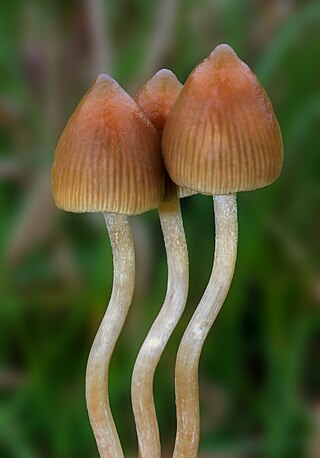
Psilocybe semilanceata, commonly known as the liberty cap, is a species of fungus which produces the psychoactive compounds psilocybin, psilocin and baeocystin. It is both one of the most widely distributed psilocybin mushrooms in nature, and one of the most potent. The mushrooms have a distinctive conical to bell-shaped cap, up to 2.5 cm (1 in) in diameter, with a small nipple-like protrusion on the top. They are yellow to brown, covered with radial grooves when moist, and fade to a lighter color as they mature. Their stipes tend to be slender and long, and the same color or slightly lighter than the cap. The gill attachment to the stipe is adnexed, and they are initially cream-colored before tinting purple to black as the spores mature. The spores are dark purplish-brown in mass, ellipsoid in shape, and measure 10.5–15 by 6.5–8.5 micrometres.

Psilocybe cyanescens, commonly known as the wavy cap or potent psilocybe, is a species of potent psychedelic mushroom. The main compounds responsible for its psychedelic effects are psilocybin and psilocin. It belongs to the family Hymenogastraceae. A formal description of the species was published by Elsie Wakefield in 1946 in the Transactions of the British Mycological Society, based on a specimen she had recently collected at Kew Gardens. She had begun collecting the species as early as 1910. The mushroom is not generally regarded as being physically dangerous to adults. Since all the psychoactive compounds in P. cyanescens are water-soluble, the fruiting bodies can be rendered non-psychoactive through parboiling, allowing their culinary use. However, since most people find them overly bitter and they are too small to have great nutritive value, this is not frequently done.
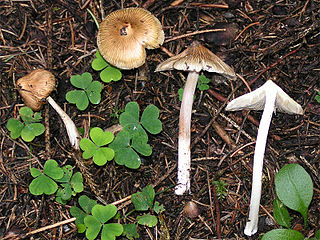
Inocybe is a large genus of mushroom-forming fungi with over 1400 species, including all forms and variations. Members of Inocybe are mycorrhizal, and some evidence shows that the high degree of speciation in the genus is due to adaptation to different trees and perhaps even local environments.
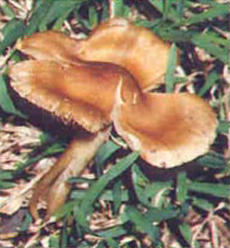
Inocybe aeruginascens is a member of the genus Inocybe which is widely distributed in Europe. The species was first documented by I. Ferencz in Ócsa, Hungary on June 15, 1965.
Inocybe tricolor is a rare member of the genus Inocybe that is widely distributed in temperate forests. It is a small mycorrhizal mushroom that contains the hallucinogens psilocybin and psilocin. Inocybe tricolor is found under Norway spruce in central Europe.

Psilocybe subaeruginosa is a species of agaric fungus in the family Hymenogastraceae described in 1927 and known from Australia and New Zealand. As a blueing member of the genus Psilocybe it contains the psychoactive compounds psilocin and psilocybin.
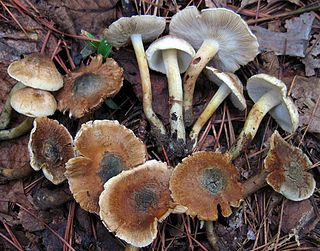
Inocybe corydalina var. corydalina, commonly known as the greenflush fibrecap, is a member of the genus Inocybe which is widely distributed in temperate forests. It is a small mycorrhizal mushroom which contains a small amount of the hallucinogen psilocybin.

Aeruginascin or N,N,N-trimethyl-4-phosphoryloxytryptamine is an indoleamine derivative which occurs naturally within the mushrooms Inocybe aeruginascens and Pholiotina cyanopus, and Psilocybe cubensis. Aeruginascin is the N-trimethyl analogue of psilocybin. It is closely related to the frog skin toxin bufotenidine (5-HTQ), a potent 5-HT3 receptor agonist, but the aeruginascin metabolite 4-HO-TMT shows strong binding at the 5-HT2 receptors similar to psilocin. The first scientific literature about the pharmacological effects of aeruginascin is from a study published by Gartz in 1989. Across 23 analyzed cases of accidental hallucinogenic mushroom poisonings, people who had ingested the mushroom Inocybe aeruginascens reported only euphoric experiences. This is in contrast to the slight and in some cases extremely dysphoric experiences reported from the accidental ingestion of non aeruginascin containing mushrooms (containing solely psilocybin and psilocin).

Inocybe lacera, commonly known as the torn fibrecap, is a poisonous species of mushroom in the genus Inocybe. Its appearance is that of a typical "little brown mushroom": small, brown and indistinct. However, it is distinguishable by its microscopic features, particularly its long, smooth spores. As with many other species of Inocybe, I. lacera contains the poisonous chemical muscarine which, if consumed, can lead to salivation, lacrimation, urination, defecation, gastrointestinal problems and vomiting. Found in Europe and North America, it typically grows in autumn in mixed woods, favouring sandy soil. There are several documented subspecies in addition to the main I. lacera var lacera, including the dwarf form I. lacera var. subsquarrosa and I. lacera var. heterosperma, found in North America.
Pluteus nigroviridis is a mushroom in the family Pluteaceae. Found in Europe, it was first described scientifically by Hungarian mycologist Margit Babos in 1983.
Inocybe coelestium is a member of the genus Inocybe which is widely distributed in Europe. It was described as new science by mycologist Thomas Kuyper in 1985. The specific epithet coelestium means 'celestials', "the inhabitants of the Mount Olympus, the gods; referring to its hallucinogenic properties."
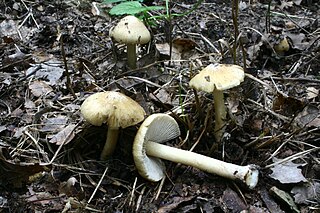
Inosperma cookei, commonly known as the straw fibrecap, is a species of mushroom in the family Inocybaceae. It was first described in 1892 by Giacomo Bresadola, and is named in honour of Mordecai Cubitt Cooke. The species is found in Europe, Asia, and North America. It produces small mushrooms of an ochre colour, with a prominent umbo, fibres on the cap and a distinctive bulb at the base of the stem. It grows from soil in mixed woodland, and is encountered in summer and autumn, though is not common. Ecologically, it feeds through use of ectomycorrhiza. Inosperma cookei has been described as both toxic and non-toxic, but either way, is not advised for consumption.
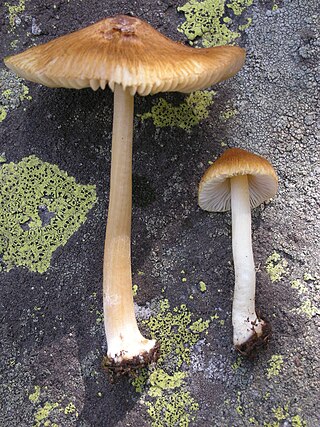
Inocybe praetervisa is a small, yellow and brown mushroom in the family Inocybaceae, distinguished from other members of the genus by its unusual spores and bulb. The unusual spores led to the species being named the type species of the now-abandoned genus Astrosporina; recent studies have shown that such a genus could not exist, as the species with the defining traits do not form a monophyletic group. However, it is a part of several clades within the genus Inocybe. I. praetervisa grows on the ground in woodland, favouring beech trees, and is found in Europe, North America and Asia. It is inedible and probably poisonous due to the presence of muscarine. The ingestion of muscarine can lead to SLUDGE syndrome, and could potentially lead to death due to respiratory failure.

Inocybe godeyi is a species of Inocybaceae fungus found in Europe. The species produces mushrooms with cone-shaped caps up to 5 cm (2 in) in diameter. The caps are cream, becoming browner, but they bruise red. The stem is up to 6 cm (2 in) long, and has a "bulb" at the base. The white flesh has a strong smell and an acrid taste. The mushrooms can be found on forest floors in autumn months; the species forms an ectomycorrhizal relationship to surrounding trees, favouring beech. I. godeyi is known to be poisonous, containing muscarine compounds, and consumption of the mushrooms can lead to SLUDGE syndrome. The species is sometimes mistaken for the deadly I. erubescens.

Inosperma calamistratum, until 2019 known as Inocybe calamistrata, is an inedible species of Inocybaceae fungus found in Europe and North America. Orson K. Miller Jr. and Hope Miller list it as poisonous. It used to be suspected of being psychotropic because of the blue-green tinge present at the stipe base, but psilocybin and similar alkaloids have not been found in the fruiting bodies.














